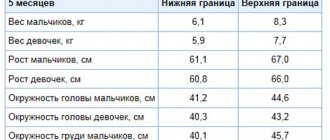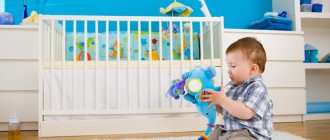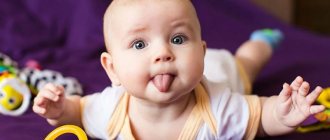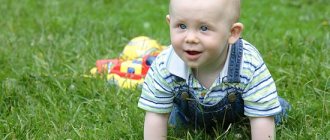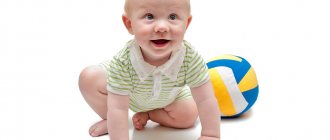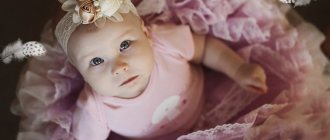Each child develops in its own way, while the physical and emotional-psychological state is susceptible to various surrounding characteristics and factors that influence the baby from the outside.
There are a sufficient number of criteria that diagnose the normal development of a child at a given age. Very often, parents do not fully understand what a baby should be able to do at 1 year and 9 months. They usually rely on recommendations from the older generation or friends who already have older children.
Little by little the child learns to be independent
He uses his mother's presence as a guarantee of the security he needs to explore the world around him. At first, when meeting strangers, the child stays close to his mother, but then leaves her for increasingly longer periods, only occasionally returning as if to maintain confidence in safety.
The same confidence is provided by the presence of a father, older brothers, sisters or any other adult to whom the child is attached.
It is at this age that children are most often frightened by new situations, such as hospitalization, attending kindergarten, or separation from their parents.
A child can be saved from such conditions if someone will work with him and will always be available to him for comfort in moments of bitterness. The greatest relief for a baby comes from the presence of a loved one, especially someone to whom he is attached. Usually parents play this role, but it is interesting and important that even very young brothers and sisters can perform this role.
Your child has become much more confident. This happens because he already knows how to walk, so he moves more quickly. The coordination of large muscles becomes more perfect.
Intellectual development of a child at 1 year and 9 months
At 1 year and 9 months, the child can do his own business longer and longer, and uses his imagination in games.
He shows care: he hugs the doll, carries it in a toy stroller, feeds it and covers it with a blanket.
The baby has already become familiar with the parts of the human body : navel, tummy, etc. and can show them not only on himself, but also on another person or doll.
The ability to observe, which goes hand in hand with memory, which is developing better and better, allows him to analyze several images at once and point out, for example, one that was not there before .
A child at this age already knows about 50-100 words and can put them into longer phrases. He talks about what he sees on the street or through the window. He is very interested in everything that is happening: pays attention to passers-by, airplanes, ambulances...
Perhaps these are the moments he is trying to depict in his drawings. Drawing with pencils is one of the abilities that your child will hone over the next few months.
A child at this age happily picks up his favorite books , leafs through them, and resolutely demands reading. Don't take them away, even if it costs a few torn pages - if a child gets used to a book from the earliest months of life, it will affect his attitude towards learning at school age.
Tips for parents:
- Turn off the TV. If it works non-stop, it is distracting, even if the baby is not paying attention to it. In addition, this way the child can, willy-nilly, get used to the TV being on all the time.
- Encourage your child to explore the world during walks. Don’t let your journey from point A to point B be boring. Draw your baby’s attention to dogs, trees, the reflection of the sky in a puddle, etc.
- Say everything slowly and clearly. If you want to explain something important to your child, sit down next to him and tell him it, looking into his eyes. Try to very clearly articulate the sounds that your baby has problems pronouncing.
- Do not blame your child if he makes a mistake during a conversation. At this age, the baby should pay attention to the content, not the form.
- Sing songs with your child. This helps in learning speech.
This age is characterized by the “I myself” phenomenon.
Along with the development of the child’s ability to be independent, the independence of his own actions begins to increase. It is clear that a child’s desire for independence often exceeds his ability to act safely and adequately.
Therefore, you have the difficult task of supporting your child in developing this autonomy, as well as improving his social skills. You will have to promote the development of these skills, while at the same time protecting your baby so that his research activities do not cross the boundaries of safety and do not encounter failures too often.
Be prepared for the fact that irritation or anger is one of the most common emotions among children of this age, and outbursts of rage, where the child screams, hits his arms and legs, or chokes, are the most common forms of expression of this emotion.
At this age, such attacks usually occur due to parental prohibitions or due to failure to achieve any goal. Putting him in bed, putting him on the potty, dressing him in tight or heavy clothes, or prohibiting him from doing something usually provokes a child's anger. Outbursts of irritation are also possible when the usual routine changes, for example, when visiting guests.
In general, the mood of people of any age largely depends on their physical condition, but this especially affects children at this stage of development. Thus, increasing irritability or frequent outbursts of anger are often the first sign of ear inflammation or some other childhood infectious disease.
Nutrition
At this age, the child should eat 4 times a day, every 3-4 hours. The most high-calorie foods should be prepared in the first half of the day. For breakfast, it is preferable to cook porridge, omelet or casserole. The diet should already include cream soup, borscht and main courses: meat and fish, vegetable stews, mashed potatoes, dairy and fermented milk products, which should remain the basis of the menu.
In addition, fresh vegetables and fruits are required: carrots, potatoes, cabbage, pumpkin, zucchini, beets. A salad of fresh cucumbers and grated tomatoes is also not prohibited. Vegetable and animal fats must be added to the diet when preparing hot dishes and salads. Meat dishes should be included in the menu every day for lunch: lean beef, rabbit meat, chicken. You can make steamed cutlets, meat puree, and meatballs from meat. Eating fish products is encouraged; they can replace meat twice a week - for example, steamed minced fish cutlets.
Puree continues to be used in the child’s diet, but ceases to be its main component. Now the baby can be slowly switched to healthy adult food
Teach your child to control his feelings
When your child becomes angry, it is very important for you not to give him any reason to think that this is the best way to satisfy his desires. If parents pay attention to the child and fulfill his wishes only when he loses his temper, the child quickly learns to behave in a way that allows him to achieve what he wants.
This practically does not happen if parents show sensitivity and understanding to the baby’s needs when he is not capricious, and if they use diverting his attention from known factors that can make the child angry as a way to deal with the child’s irritability. Sometimes, immediately after the onset of an attack of irritability, it is better not to notice it until the baby calms down, and only then console him.
Throughout early childhood, the types of most common emotional problems change. For children in the first year of life, the most typical difficulties are associated with eating or sleeping, and in the second year, anxiety states due to separation from parents or loved ones become more frequent. Problems also arise around quarrels between parents and children, when forming relationships of subordination.
Physical development of the child:
- Not only walks, but also runs well.
- He stumbles less and less often because he looks at his feet as he runs.
- Runs around small objects that it encounters on its way.
- Climbs stairs without assistance (while standing on each step with both feet).
- It is still difficult for him to go down the stairs without outside help.
- Can squat.
- Jumps not only in place, but also forward.
- Able to get out of the playpen.
- Opens the door to the room.
- He kicks the ball, almost missing.
- Throws the ball up.
Daily regime
Dream
Some babies can take two more naps a day, but most have moved to one nap during the day. Pediatricians advise increasing bedtime at night: you can read an evening story after 20.00.
Nutrition
The diet should include first and second courses. Breakfast should be light (milk porridge, vegetable stew, omelet), and lunch and dinner should be the same in calorie content.
It is allowed to serve pureed soups, borscht, meat and fish dishes, side dishes, mashed potatoes and dairy products. Fruits and vegetables cannot be excluded, except those that cause allergic reactions.
Forget about any low-fat food. Fat is a building material for a growing body. It enriches the tissues of the brain and nervous system.
Walks
Continue to walk as much as possible with your toddler, combining time in the fresh air with active recreation or developmental activities. Try to react correctly to manifestations of research interest: the baby got into the puddle not because he wanted to upset his mother, but to test the depth and test the strength of his favorite boots.
Mental development of the child:
- The child is emotional and demanding.
- He enjoys playing not only with toys, but also with any household items. Invites loved ones to the game.
- Loves music. When rhythmic music plays, he dances; When he hears a song, he sings along. Sometimes he even sings without accompaniment.
- He draws, or rather carefully sketches. When there is nothing to copy from, he enjoys filling a sheet of paper with scribbles.
- The baby needs toys. They help to spend time usefully, and secondly, they develop observation, imagination and attention.
What toys does a child need at this age?
For speech development:
- pictures and cubes with images of individual objects, toys, animals, transport, objects in action;
- little books with nursery rhymes.
To develop movements:
- balls of different sizes;
- hoop;
- moving cars; gurneys.
For a story game:
- dolls;
- toy animals, birds;
- doll furniture - table, chair, bed, mattress, blanket;
- children's dishes;
- doll clothes;
- baby, bath and stroller for him.
To develop subject activity:
- matryoshka toys;
- pyramid;
- ribbons;
- colored cubes;
- scoops and buckets, sand molds;
- constructors.
To get acquainted with the concepts of shape and color
For kids, a good toy would be an educational structure, which experts call rather boringly - an active cube
.
Most often, such a toy is a cube, a cylinder or even a house with a roof and a pipe, which has transparent walls and holes of different shapes into which the child needs to insert figures of the appropriate configuration and the desired color; there are also keys, by turning which the child will hear a pleasant melody .
In addition to the fact that the active cube introduces the baby to the concepts of shape and color, it helps the child take the first step towards learning to establish cause-and-effect relationships between his actions and events in general. In addition, this is a great exercise for your baby's developing intelligence.
Development at 1.9 - 2 years: what a child should be able to do
Development at
1.9 - 2 years : what a child should be able to do
For every parent, the most exciting question is how correctly their child is developing. There are no strict limits on what children should be able to do at a given age, because each of them is individual. The skills developed by a particular child are not a general indicator of development. What comes easily to one child may not always be possible for another. However, there is a generally accepted minimum set of skills that children should have in
1.9 - 2 years.
Physical development
The physical and mental development of children of early preschool age are closely related, which is why mothers carefully monitor when the baby began to sit up on his own, when he took his first steps, and how correctly his motor abilities are formed in the future. The movements that a child of 1.9 - 2 years can make are already quite coordinated and varied:
- easily overcomes obstacles, stepping over them, often jumping over them;
- bounces in place without losing balance;
- changes from walking to running;
- when going down and up the stairs, alternates legs;
- throws and catches the ball from close range, kicks it, holds it in his hands;
- maintains balance while moving along a board lying on the floor or along a sidewalk curb (here it is better to hold the baby for now);
- loves to dance to energetic music, and adults are often surprised by their child’s sense of rhythm;
- turns the pages of the book, grabbing, however, only a few pages at once;
- draws vertical and horizontal lines and uneven ovals with a pencil.
This age is dangerous because the little fidget still does not know how to assess his strength, and he has practically no feeling of fear. He can climb to a height and try to get down from there on his own; he does not always estimate the distance to an obstacle and cannot stop in time in front of it. At this age, injuries often occur, sometimes quite serious. The task of parents is to carefully monitor the child, preventing falls and bruises.
Speech skills
The most controversial issue is the development of speech in a two-year-old child. Some children by the age of 1.9 - 2 years can repeat children's poems after adults, others only know “mom” and “dad”. And the second case is not a deviation from the norm at all. There are many factors influencing speech development. Thus, it has been noticed that boys begin to speak later than their girls the same age. Children who attend children's groups will also speak earlier. During the second year of life, about 200 words, as a rule, appear in the baby's vocabulary, and speech skills consist of the following:
- substitute words and onomatopoeia are replaced with correct pronunciation;
- repeats words after adults, not always understanding their meaning;
- actively asks questions, the first among which is “what is this?”;
- in conversation can talk about himself in the third person;
- makes sentences of three or more words;
- expresses his thoughts coherently, can compose a text of 3-5 simple sentences, talking about the events of the day;
- distinguishes antonyms (big - small, top - bottom, long - fast);
- names familiar objects in pictures, can describe the action depicted in them;
- pronounces his own name and the names of acquaintances, uses direct addresses.
You need to speak to your child clearly, without distorting words, ensuring that new words are repeated with an understanding of their meaning.
Social skills
The child tries to do everything on his own. You need to help him only in case of obvious unsuccessful attempts, explaining how to do it correctly so that it will work next time. The list of what a child aged 1.9 - 2 years should be able to do in terms of everyday skills is conditional and depends only on how much the parents were able to instill them in the baby:
- holds a spoon and eats independently carefully, without getting dirty or dropping food;
- washes hands independently;
- currently brushes teeth with the help of an adult;
- he puts on his hat, socks, and mittens;
- tries to put on tights or a jacket, boots, but more often gets confused, putting both legs in one pant leg, confusing the left and right legs;
- is able to control his physiological abilities: he asks to go to the potty, but still cannot stand it for a long time (nighttime needs also remain uncontrollable).
Cognitive skills. Thinking
A child’s thinking directly depends on speech, so you need to constantly talk to him, comment on any action, explain and explain, without leaving a single question unanswered. The basic skills of a two-year-old child, which are considered minimal, are the following:
- distinguishes objects according to their characteristics: large - small, warm - cold;
- independently assembles a pyramid of up to 6 rings, taking into account their size;
- distinguishes up to 8 colors;
- compares and contrasts objects, groups them by shape, size and color;
- knows basic geometric shapes - circle, triangle, square;
- repeats the sequence of movements, learning the simplest dances or elements of gymnastics;
- easily folds a matryoshka doll or one object into another;
- collects puzzles consisting of 2-4 elements.
At this age, imitative activity is very developed. Any activity of an adult is accompanied by the exclamation: “Me too!” There is no need to discourage such enthusiasm. When cleaning, you can give your child his own cloth to wipe the dust or wash the floors, let him put the dug up potatoes in a bucket while working in the garden. A two-year-old child is able to absorb a large amount of information, easily remembering and repeating everything he sees and is explained to him.

